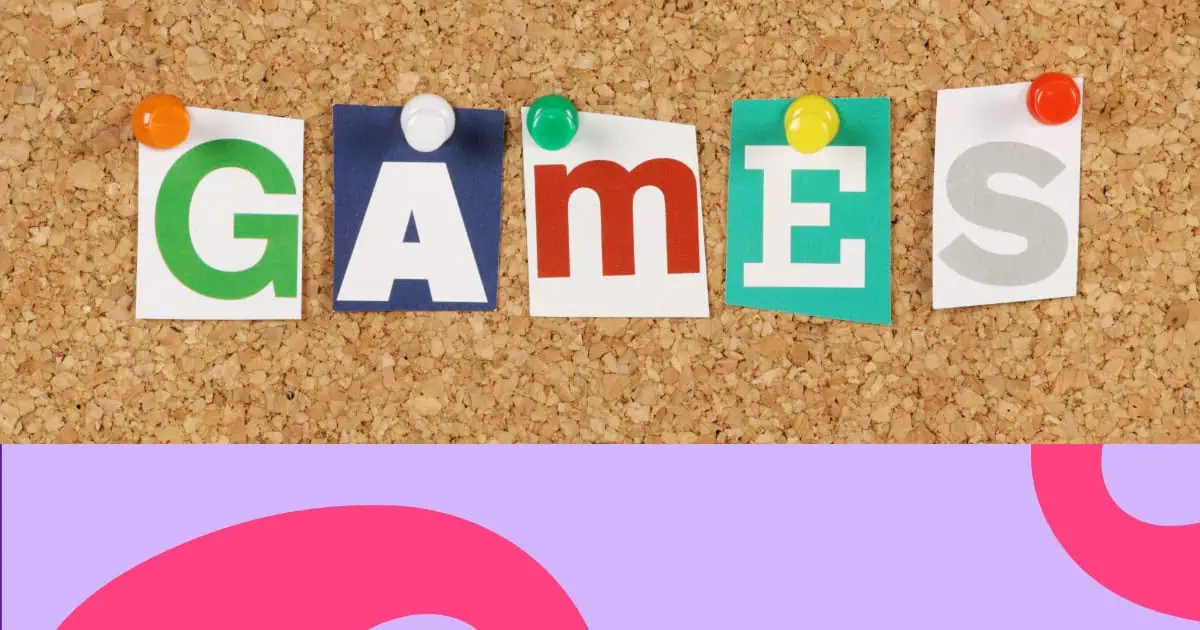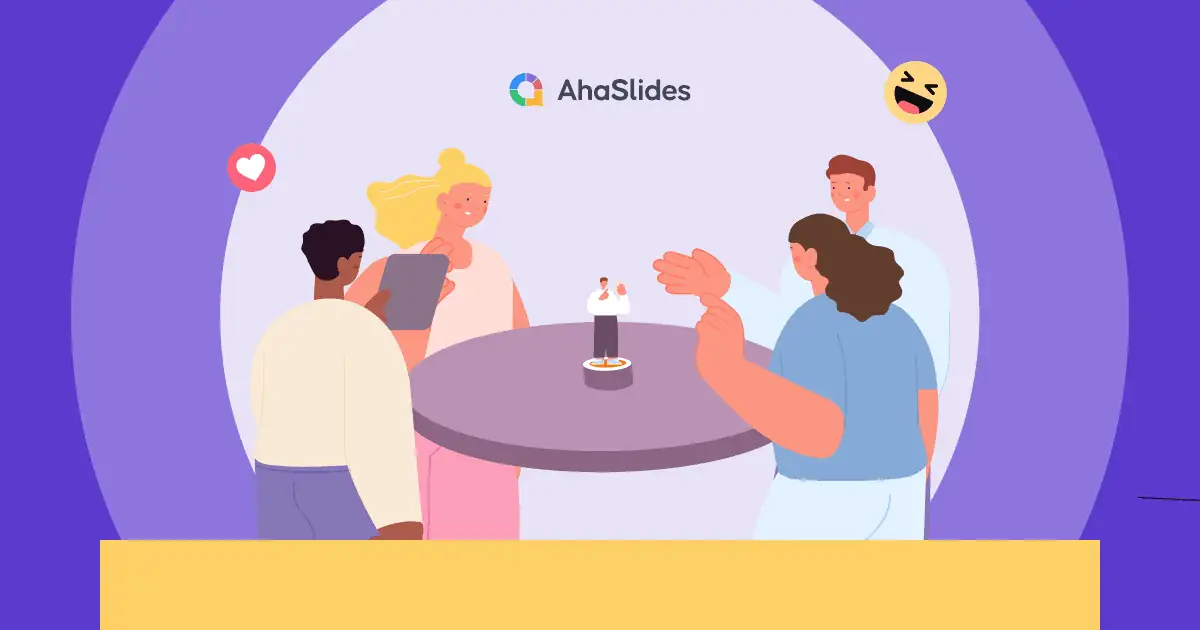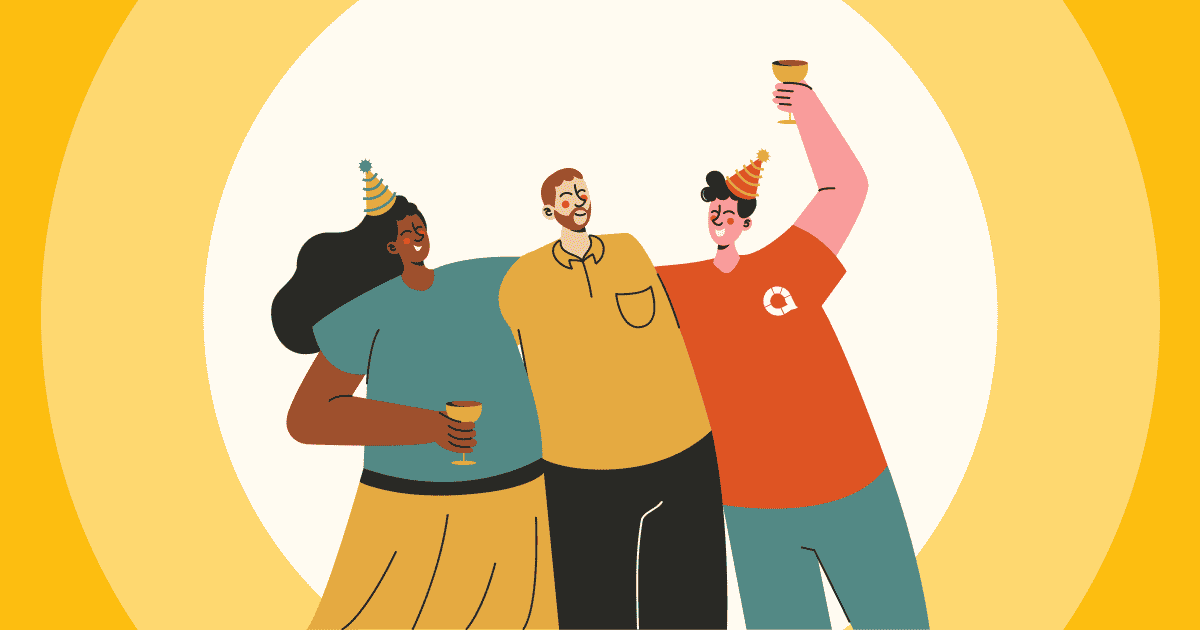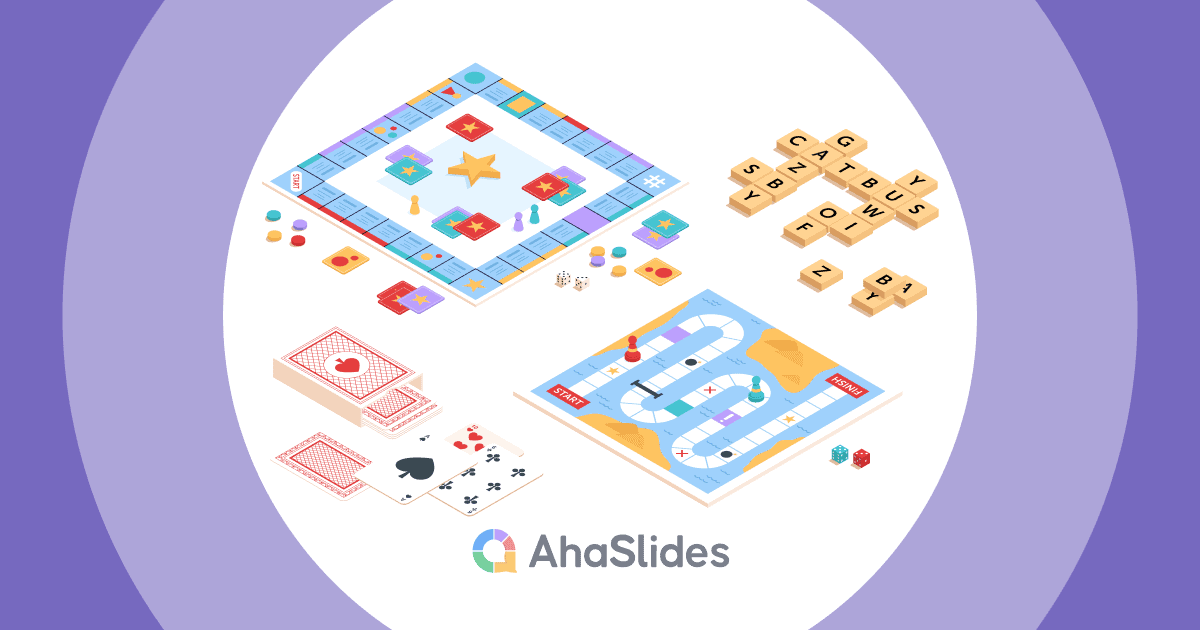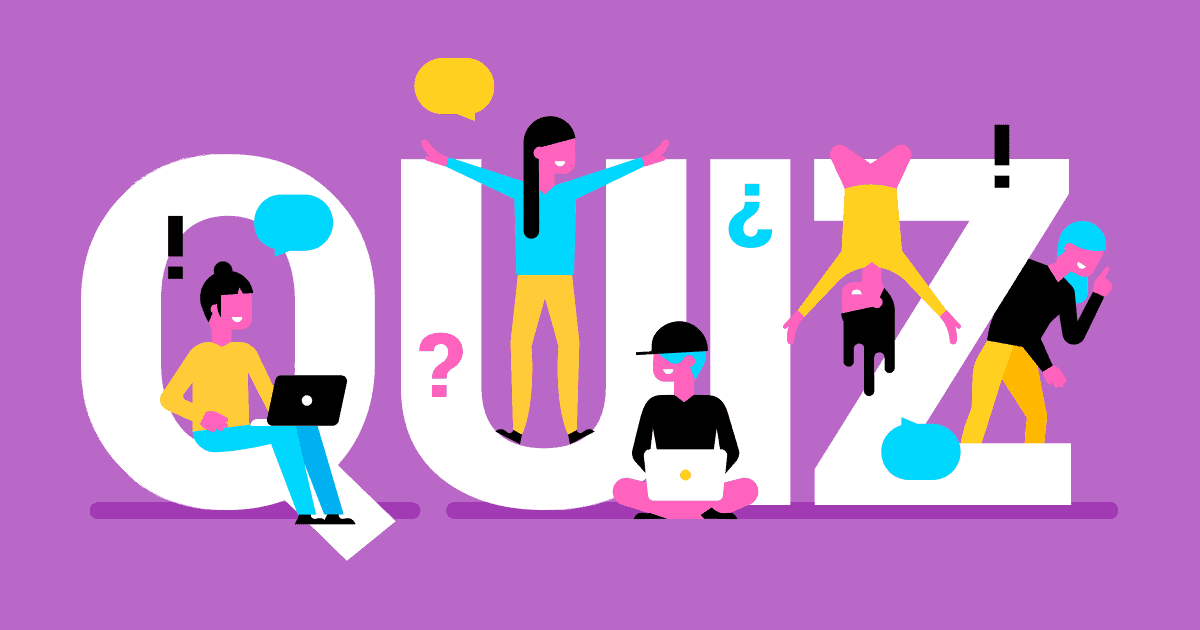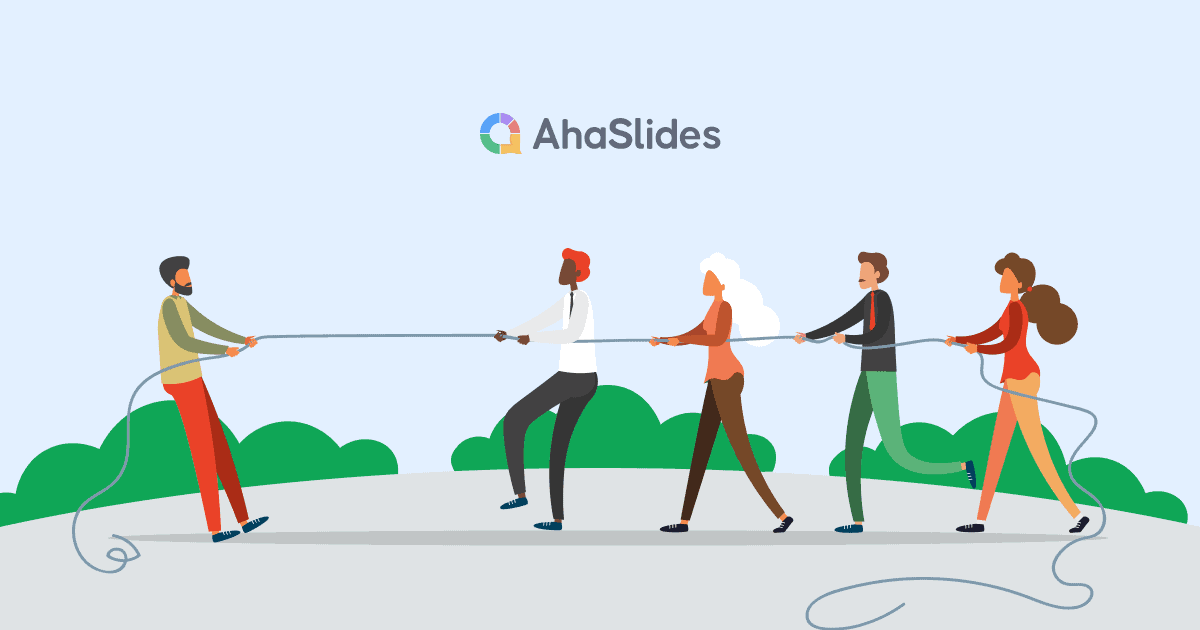Jere yon gwo gwoup ki gen plis pase 20 patisipan prezante defi inik. Kit w ap fasilite ranfòsman ekip antrepriz, dirije yon atelye fòmasyon, oswa òganize yon evènman, pou kenbe tout moun angaje an menm tan, ou bezwen jwèt ak aktivite ki apwopriye yo.
Kle a se chwazi jwèt ki ankouraje kolaborasyon, ki ankouraje patisipasyon tout manm yo, epi ki adapte ak diferan kontèks—soti nan sal konferans rive nan espas deyò ak reyinyon vityèl. Gid sa a prezante 20 jwèt gwo gwoup ki pwouve efikasite yo òganize pa kalite ak kontèks, pou ede ou chwazi aktivite pafè a pou bezwen espesifik ou yo.
Lis Jwèt Gwo Gwoup
Briz-glas rapid ak enèji (5-15 minit)
Pafè pou kòmanse reyinyon, separe sesyon ki long, oswa bati yon premye rapò..
1. Kesyon ak kesyon
Pi bon pou: Kòmanse reyinyon, teste konesans, konpetisyon amikal
Gwosè gwoup: Unlimited
Tan: 10-20 minit
Fòma: An pèsòn oswa vityèl
Pa gen anyen ki pi bon pase yon bon ti egzamen trivia pou yon angajman imedya. Bote a se fleksibilite li—ou ka pèsonalize kesyon yo selon endistri w la, kilti konpayi w la, oswa sijè sesyon an. Ekip yo kolabore, enèji konpetitif la ogmante, e menm patisipan ki pa twò pale yo antre nan diskisyon an.
Platfòm modèn tankou AhaSlides elimine tèt fè mal lojistik egzamen tradisyonèl yo. Patisipan yo rantre atravè telefòn yo, repons yo parèt an tan reyèl, epi tablo klasman yo kreye yon momantòm natirèl. Ou kontwole difikilte a, ritm lan, ak tèm yo pandan teknoloji a jere nòt yo ak ekspozisyon an.
Kle pou yon trivia efikas: balanse kesyon difisil ak kesyon ou ka reyalizab, chanje ant sijè serye ak sijè lejè, epi kenbe wonn yo kout pou kenbe momantòm.
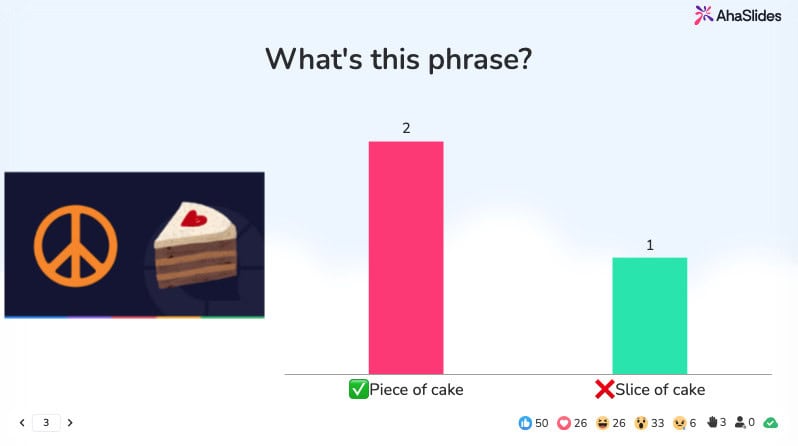
2. De verite ak yon manti
Pi bon pou: Nouvo ekip, bati bon rapò, dekouvri pwen komen
Gwosè gwoup: 20-50 patisipan yo
Tan: 10-15 minit
Fòma: An pèsòn oswa vityèl
Jwèt klasik sa a pou kraze glas revele enfòmasyon etonan toutpandan l ap ankouraje patisipasyon tout moun. Chak moun pataje twa deklarasyon sou tèt yo—de vre, youn fo. Gwoup la diskite epi vote sou sispèk manti a.
Sa ki fè l mache: moun yo natirèlman vle konnen plis bagay sou kòlèg yo, fòma a anpeche nenpòt moun domine konvèsasyon an, epi moman revelasyon an kreye yon vrè sipriz ak ri. Pou gwoup ki pi gwo, divize yo an ti sèk 8-10 moun pou asire tout moun jwenn ase tan pou pale.
Pi bon deklarasyon yo konbine manti ki kredib ak verite ki pa kredib. "Mwen pa janm kite peyi m" ka yon manti, alòske "Mwen te konn kwit manje pou yon atlèt olenpik" se vre.
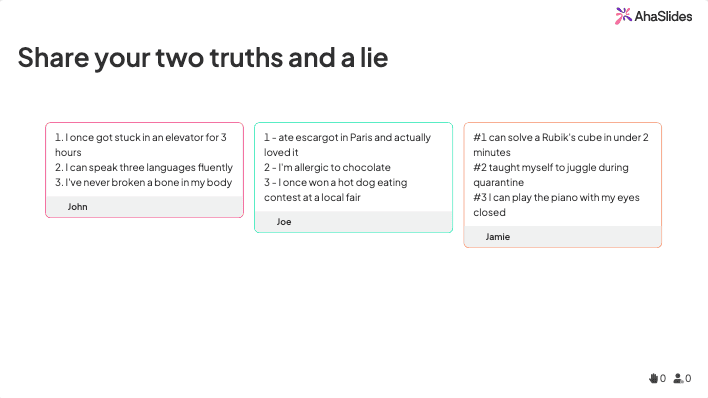
3. Avètisman
Pi bon pou: Sesyon plen enèji, fèt, evènman ekip aksidantèl
Gwosè gwoup: 20-50 patisipan yo
Tan: 15-20 minit
Fòma: An pèsòn (ou ka adapte l pou yon reyinyon vityèl)
Ellen DeGeneres te rann jwèt devinèt rapid sa a popilè, li fè tout moun ri epi fè yo bouje. Yon moun kenbe yon kat oswa yon aparèy sou fwon li ki montre yon mo oswa yon fraz. Kamarad ekip yo rele endis pandan jwè a ap eseye devine anvan tan an fini.
Kreye jwèt kat pèsonalize ki gen rapò ak kontèks ou a—jagon endistri a, pwodwi konpayi an, blag anndan ekip la. Kontni espesifik la mwens enpòtan pase enèji li kreye a. Jwè yo ap kouri kont tan, koekipye yo kolabore sou estrateji pou bay endikasyon, epi tout sal la ap manje eksitasyon an.
Pou gwo gwoup, òganize plizyè jwèt an menm tan epi gayan yo ap konpetisyon nan yon dènye wonn chanpyona.
4. Simon di
Pi bon pou: Ranfòsman rapid, poz konferans, chofe fizik
Gwosè gwoup: 20-100+ patisipan
Tan: 5-10 minit
Fòma: Nan-moun
Senplisite li fè li ekselan pou gwo gwoup. Youn nan lidè yo bay lòd fizik—"Simon di touche zòtèy ou"—epi patisipan yo obeyi sèlman lè fraz la gen ladan l "Simon di." Si ou retire fraz la, patisipan ki swiv lòd la elimine.
Poukisa li fonksyone malgre orijin li nan anfans: li pa mande okenn preparasyon, li fonksyone nan nenpòt espas, li bay mouvman fizik apre ou fin chita, epi eliminasyon konpetitif la kreye angajman. Ogmante difikilte a lè w akselere kòmandman yo, konbine plizyè aksyon, oswa enkòpore mouvman espesifik nan endistri a.

Fòmasyon Ekip Kolaboratif (20-45 minit)
Aktivite sa yo bati konfyans, amelyore kominikasyon, epi devlope ladrès pou rezoud pwoblèm atravè defi pataje. Ideyal pou sesyon devlopman ekip ak pou bati relasyon ki pi pwofon.
5. Sal chape
Pi bon pou: Rezoud pwoblèm, kolaborasyon anba presyon, lyezon ekip
Gwosè gwoup: 20-100 (ekip 5-8)
Tan: 45-60 minit
Fòma: An pèsòn oswa vityèl
Chanm chape yo fòse ekip yo travay ansanm anba presyon tan, pou rezoud pezeul ki konekte youn ak lòt pou "chape" anvan kontaj la fini. Fòma a natirèlman distribye lidèchip pandan diferan kalite pezeul favorize diferan fòs—pansè lojik yo abòde kòd, moun ki trete vèbal yo jere devinèt, moun k ap aprann vizyèlman yo detekte modèl kache.
Chanm evazyon fizik yo ofri anviwònman imersif men yo mande pou fè rezèvasyon ak vwayaj. Chanm evazyon vityèl yo mache byen pou ekip ki a distans, elimine lojistik pandan y ap kenbe defi prensipal la. Platfòm yo bay fasilitasyon pwofesyonèl, asire eksperyans san pwoblèm menm avèk patisipan ki gaye toupatou.
Pou gwo gwoup, dirije plizyè sal an menm tan oubyen kreye defi estil relè kote ekip yo ap pase nan diferan devinèt youn apre lòt. Rezime apre match la revele enfòmasyon sou modèl kominikasyon, lidèchip k ap parèt, ak apwòch pou rezoud pwoblèm.
6. Fèt Mistè Asasina
Pi bon pou: Evènman aswè, sesyon ekip pwolonje, angajman kreyatif
Gwosè gwoup: 20-200+ (divize an mistè separe)
Tan: 1-2 èdtan
Fòma: Prensipalman an pèsòn
Transfòme ekip ou a an detektif amatè k ap mennen ankèt sou yon krim ki te fèt sou sèn. Patisipan yo resevwa asiyasyon pèsonaj, endis parèt pandan tout evènman an, epi ekip yo kolabore pou idantifye asasen an anvan tan an fini.
Eleman teyatral la distenge mistè asasina yo ak aktivite tipik yo. Patisipan yo angaje yo nan wòl yo, kominike nan pèsonaj yo, epi yo fè eksperyans satisfaksyon pou rezoud pezeul konplèks yo. Fòma a akomode gwo gwoup lè li fè mistè paralèl—chak gwoup envestige diferan ka ak solisyon inik.
Siksè mande preparasyon: pake detaye sou pèsonaj yo, endis ki byen prepare, yon delè klè, ak yon fasilitatè k ap jere revelasyon yo. Twous mistè asasina ki deja pare yo bay tout sa ou bezwen, men kreye mistè pèsonalize ki adapte ak òganizasyon w lan ajoute yon pèsonalizasyon memorab.
7. lachas Scavenger
Pi bon pou: Eksplore nouvo espas, evènman deyò, defi kreyatif
Gwosè gwoup: 20-100+ patisipan
Tan: 30-60 minit
Fòma: An pèsòn oubyen dijital
Lachas trezò yo angaje ensten konpetitif yo tout pandan y ap ankouraje eksplorasyon ak kreyativite. Ekip yo kouri pou konplete defi, jwenn objè espesifik, oswa pran prèv fotografik anvan tan fini. Fòma a adapte san rete—bilding biwo, lari vil, pak, oswa menm espas vityèl.
Varyasyon modèn yo enkli lachas trezò foto kote ekip yo soumèt foto ki pwouve yo fin fè travay la, lachas ki baze sou defi ki mande ekip yo pou yo fè travay espesifik, oswa fòma ibrid ki konbine eleman fizik ak dijital.
Eleman konpetitif la motive angajman, varyete defi yo akomode diferan fòs, epi mouvman an bay enèji fizik. Pou ekip vityèl yo, kreye jwèt lachas trezò dijital kote patisipan yo jwenn enfòmasyon espesifik sou sit entènèt konpayi yo, jwenn kòlèg ki gen eksperyans patikilye, oswa konplete defi sou entènèt.
8. Lougarou
Pi bon pou: Panse estratejik, dediksyon, evènman sosyal aswè
Gwosè gwoup: 20-50 patisipan yo
Tan: 20-30 minit
Fòma: An pèsòn oswa vityèl
Jwèt dediksyon sosyal sa a mete patisipan yo nan wòl sekrè—vilajè, lougawou, yon divinò, ak yon medsen. Pandan faz "lajounen", vilaj la diskite epi vote pou elimine lougawou yo sispèk. Pandan faz "lannwit", lougawou yo chwazi viktim yo pandan divinò a ap mennen ankèt epi medsen an ap pwoteje.
Sa ki fè l enteresan: jwè yo dwe dedwi wòl lòt moun atravè konpòtman, modèl lapawòl, ak chwa vòt. Lougarou yo kolabore an sekrè pandan vilajwa yo ap travay ak enfòmasyon ki pa konplè. Tansyon an ap ogmante pandan tout wonn yo pandan gwoup la ap diminye posiblite yo atravè eliminasyon ak dediksyon.
Platfòm vityèl yo fasilite plasman wòl ak aksyon faz lannwit, sa ki fè sa etonan efikas pou ekip distribye yo. Jwèt la mande yon konfigirasyon minimòm, li adapte fasilman, epi li kreye moman sipriz memorab lè idantite yo revele.
9. Charad
Pi bon pou: Kraze tansyon, ankouraje kreyativite, angajman ki pa gen anpil teknoloji
Gwosè gwoup: 20-100 patisipan yo
Tan: 15-30 minit
Fòma: An pèsòn oswa vityèl
Charad transande baryè lang yo grasa fòma inivèsèl li a: yon moun jwe yon mo oswa yon fraz avèk jès sèlman pandan koekipye yo ap rele devine anvan tan an fini. Restriksyon sou kominikasyon vèbal la fòse ekspresyon fizik kreyatif ak obsèvasyon atansyon.
Pèsonalize kontni an selon kontèks ou a—terminoloji endistri a, pwodwi konpayi an, sitiyasyon nan espas travay la. Mo espesifik yo mwens enpòtan pase enèji ki pwodui lè w ap gade kòlèg yo ap kominike atravè jès ki pi dezespere.
Pou gwo gwoup, òganize konpetisyon similtane oswa gwoup tounwa kote gayan yo avanse. Platfòm dijital yo ka chwazi mo o aza, fè wonn tan, epi swiv nòt yo otomatikman.
10. Piksyonè
Pi bon pou: Kominikasyon vizyèl, panse kreyatif, plezi aksesib
Gwosè gwoup: 20-60 patisipan yo
Tan: 20-30 minit
Fòma: An pèsòn oswa vityèl
Menm jan ak charad men yo itilize desen olye de jès. Patisipan yo fè eskiz reprezantasyon pandan koekipye yo devine mo a oswa fraz la. Talan atistik la pa enpòtan—desen terib yo souvan jenere plis ri ak rezolisyon pwoblèm kreyatif pase travay atistik byen fini.
Fòma a natirèlman egalize teren jwèt la. Kapasite atistik ede men li pa desizif; kominikasyon klè ak panse lateral souvan pwouve pi enpòtan. Tout moun ka patisipe kèlkeswa orijin oswa kapasite fizik yo.
Tablo blan dijital yo pèmèt vèsyon vityèl, sa ki pèmèt patisipan ki a distans yo desine pandan y ap pataje ekran. Pou gwoup an pèsòn, gwo tablo blan oswa tablo baskile ki pozisyone devan pèmèt tout moun obsève an menm tan.
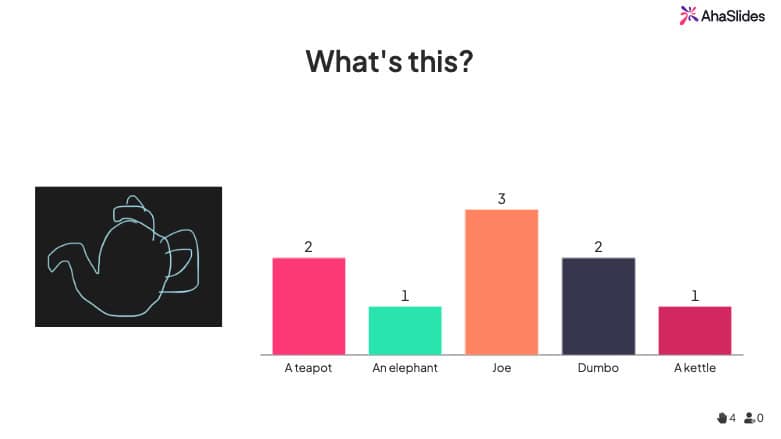
Aktivite fizik ak deyò (30+ minit)
Lè espas la pèmèt, epi tan an kolabore, aktivite fizik yo bay gwoup yo enèji pandan y ap bati kamaradri atravè efò pataje. Sa yo pi byen mache pou retrèt, evènman deyò, ak jounen dedye pou ranfòse ekip.
11. Lazè Tag
Pi bon pou: Fòmasyon ekip ki gen anpil enèji, gwoup konpetitif, espas deyò
Gwosè gwoup: 20-100+ patisipan
Tan: 45-60 minit
Fòma: An pèsòn (yon kote espesyalize)
Lazè tag konbine aktivite fizik ak panse estratejik. Ekip yo deplase sou teren jwèt la, kowòdone atak, defann teritwa, epi sipòte koekipye yo—tout pandan y ap jere pèfòmans endividyèl. Jwèt la mande yon eksplikasyon minimòm, li akomode diferan nivo kondisyon fizik, epi li bay rezilta mezirab atravè nòt otomatik.
Ekipman an jere konpleksite; patisipan yo tou senpleman vize epi tire. Fòma konpetitif la kreye yon lyezon natirèl nan ekip la pandan gwoup yo ap fè estrateji, kominike, epi selebre viktwa ansanm. Pou gwo gwoup yo, ekip ki chanje youn apre lòt asire ke tout moun ap jwe pandan y ap kenbe gwosè wonn yo rezonab.
12. Rale kòd (Tire kòd)
Pi bon pou: Evènman deyò, konpetisyon ekip kri, defi fizik
Gwosè gwoup: 20-100 patisipan yo
Tan: 15-20 minit
Fòma: An pèsòn (deyò)
Konpetisyon fizik pi distile nan sans li: de ekip, yon kòd, ak yon tès fòs ak kowòdinasyon kolektif. Senplisite a fè li pwisan. Siksè mande efò senkronize, pozisyonman estratejik, ak angajman kontinyèl nan men chak manm ekip la.
Anplis defi fizik la, tire kòd kreye eksperyans pataje memorab. Ekip yo selebre viktwa ki difisil pou reyalize, aksepte defèt avèk jantiyès, epi sonje santiman viseral travay ansanm pou yon objektif komen.
Konsiderasyon sekirite yo enpòtan: sèvi ak kòd ki apwopriye, asire ekip yo egal, evite sifas ki di, epi etabli règ klè sou fason pou lage kòd la.
13. Kayak/Kano
Pi bon pou: Retrè pandan ete, fòmasyon ekip avanti, amatè aktivite deyò
Gwosè gwoup: 20-50 patisipan yo
Tan: 2-3 èdtan
Fòma: An pèsòn (kote dlo a)
Aktivite akwatik yo ofri opòtinite inik pou ranfòse ekip. Kayak ak kannòt mande kowòdinasyon ant patnè yo, prezante defi pataje, epi kreye eksperyans memorab nan anviwònman natirèl.
Fòma a akomode konpetisyon atravè kous oswa defi kolaboratif tankou pagayaj senkronize. Anviwònman an retire patisipan yo nan anviwònman travay tipik, ankouraje diferan entèraksyon ak konvèsasyon. Defi fizik la mande konsantrasyon, pandan ke anviwònman natirèl la ankouraje detant.
Kolabore avèk sant aktivite deyò pwofesyonèl pou jere ekipman, asire sekirite, epi bay enstriksyon. Envestisman an bay bon rezilta atravè eksperyans inik ke sal konferans estanda yo pa ka repwodui.
14. Chèz Mizikal
Pi bon pou: Briz glas ak anpil enèji, aktivite fizik rapid, tout laj
Gwosè gwoup: 20-50 patisipan yo
Tan: 10-15 minit
Fòma: Nan-moun
Klasik timoun sa a tradui etonanman byen pou gwoup granmoun. Patisipan yo ap fè wonn chèz pandan mizik la ap jwe, yo ap lite pou jwenn plas lè mizik la sispann. Chak wonn elimine yon patisipan epi retire yon chèz jiskaske yon gayan sòti.
Enèji frenetik la jenere ri epi kraze baryè pwofesyonèl yo. Ritm rapid la kenbe angajman an, epi règ senp yo pa mande okenn eksplikasyon. Sèvi ak seleksyon mizik pou bay ton an—pop ritmik pou evènman aksidantèl, im motivasyonèl pou gwoup konpetitif.
15. Swiv Lidè a
Pi bon pou: Chofaj fizik, enèji, kowòdinasyon senp
Gwosè gwoup: 20-100+ patisipan
Tan: 5-10 minit
Fòma: Nan-moun
Yon moun demontre mouvman yo pandan tout moun imite an menm tan. Kòmanse ak mouvman senp—fè sèk ak bra, fè sote sou kote—epi ogmante konpleksite a pandan gwoup yo ap chofe. Lidè ki deziyen an ap chanje pozisyon, sa bay plizyè moun opòtinite pou gide gwoup la.
Sa ki fè li efikas: pa gen okenn preparasyon, li fonksyone nan espas limite, li pèmèt ou fè aktivite fizik apre ou fin chita, epi li adapte ak tout nivo kapasite fizik grasa yon difikilte reglabl.
Jwèt Klasik pou Fèt ak Sosyal (10-30 minit)
Fòma familye sa yo mache byen pou evènman ekip aksidantèl, selebrasyon, ak rasanbleman sosyal kote atmosfè a ta dwe santi l rilaks olye ke estriktire.
16. Bengo
Pi bon pou: Evènman aksidantèl, gwoup melanje, patisipasyon fasil
Gwosè gwoup: 20-200+ patisipan
Tan: 20-30 minit
Fòma: An pèsòn oswa vityèl
Apèl inivèsèl Bingo a fè li pafè pou gwoup divès. Pèsonalize kat yo selon kontèks ou a—gwo etap enpòtan nan konpayi an, tandans nan endistri a, enfòmasyon sou manm ekip yo. Mekanik senp yo akomode tout laj ak orijin pandan y ap kreye moman eksitasyon kolektif pandan patisipan yo prèt pou fini.
Platfòm dijital yo elimine preparasyon kat, otomatize apèl yo, epi mete ganyan yo an evidans imedyatman. Natirèl o aza a asire jistis, epi datant ant apèl yo kreye opòtinite konvèsasyon natirèl.
17. Bonm nan eksploze
Pi bon pou: Moun ki renmen pran enèji rapid, ki panse anba presyon
Gwosè gwoup: 20-50 patisipan yo
Tan: 10-15 minit
Fòma: An pèsòn oswa vityèl
Patisipan yo pase yon "bonm" imajinè pandan y ap reponn kesyon yo. Lè tan an fini, bonm nan "eksploze" epi moun ki gen bonm nan ap fè fas ak eliminasyon. Presyon tan an kreye ijans, eliminasyon o aza a ajoute sispens, epi fòma senp lan mande yon ti preparasyon.
Pèsonalize kesyon yo selon bezwen ou yo—kesyon espesyal, enfòmasyon pèsonèl, defi kreyatif. Jwèt la mache byen ni kòm yon aktivite pou aprann konnen lòt moun ni kòm yon tès konesans espesifik.
18. Bonbonye
Pi bon pou: Evènman sosyal pou granmoun, rasanbleman aswè
Gwosè gwoup: 20-40 patisipan yo
Tan: 15-20 minit
Fòma: Nan-moun
Sèvi ak yon pil kat estanda, bay chak moun wòl sekrè: Candyman an (As), Polisye a (Wa), ak Achtè yo (kat nimewo). Candyman an "vann sirèt" an kachèt bay achtè yo atravè siy je oswa siyal sibtil. Achtè yo soti nan jwèt la lè yo fin achte. Polisye a dwe idantifye Candyman an anvan tout sirèt yo vann.
Eleman twonpri a kreye entrig, siyal sekrè yo jenere ri, epi ankèt polisye a ajoute sispens. Jwèt la natirèlman jenere istwa patisipan yo pataje lontan apre evènman an fini.
19. Piramid (Jwèt Bwè)
Pi bon pou: Evènman sosyal pou granmoun, rasanbleman aksidantèl apre lè travay
Gwosè gwoup: 20-30 patisipan yo
Tan: 20-30 minit
Fòma: Nan-moun
Kat yo ranje an fòmasyon piramid kreye yon jwèt bwè ak miz k ap ogmante. Jwè yo vire kat yo swivan règ espesifik, pran desizyon estratejik sou ki lè pou yo defi lòt moun oswa pwoteje tèt yo. Fòma a konbine memwa, blòf, ak chans.
Nòt: Sa a sèlman mache pou kontèks sosyal ki apwopriye kote konsomasyon alkòl akeyi. Toujou bay altènativ ki pa gen alkòl epi respekte chwa patisipan yo.
20. 3 Men, 2 Pye
Pi bon pou: Kowòdinasyon fizik, rezoud pwoblèm an ekip, defi rapid
Gwosè gwoup: 20-60 patisipan yo
Tan: 10-15 minit
Fòma: Nan-moun
Ekip yo resevwa kòmandman ki mande yo pou yo ranje tèt yo yon fason pou yon kantite men ak pye espesifik touche tè a. "Kat men, twa pye" fòse yon pozisyonman kreyatif ak kolaborasyon pandan manm ekip yo ap sipòte youn lòt, leve janm, oswa kreye eskilti imen.
Defi fizik la jenere ri, li mande kominikasyon ak kowòdinasyon, epi li fonksyone kòm yon rapid sous enèji ant aktivite ki pi long. Ogmante difikilte a ak konbinezon ki pi konplèks oswa kòmandman ki pi rapid.
Vanse
Diferans ki genyen ant eksperyans ekip memorab ak eksperyans pèdi tan moun ka bliye souvan depann de preparasyon ak seleksyon aktivite ki apwopriye. Jwèt ki nan gid sa a mache paske yo te teste yo nan plizyè kontèks, yo te amelyore yo atravè repetisyon, epi yo te pwouve efikasite yo ak gwoup reyèl.
Kòmanse senp. Chwazi youn oubyen de aktivite ki koresponn ak kontrent evènman kap vini an. Prepare byen. Egzekite avèk konfyans. Obsève sa ki enterese gwoup espesifik ou a, epi repete.
Animasyon gwo gwoup amelyore avèk pratik. Chak sesyon anseye ou plis bagay sou tan, jesyon enèji, ak lekti dinamik gwoup. Animatè ki eksele yo pa nesesèman pi karismatik yo—se yo menm ki chwazi aktivite ki apwopriye yo, ki prepare avèk dilijans, epi ki ajiste selon fidbak yo.
Pare pou transfòme pwochen gwo evènman gwoup ou a? AhaSlides bay modèl gratis ak zouti entèaktif ki fèt espesyalman pou fasilitatè k ap jere gwoup tout gwosè, nenpòt kote nan mond lan.
Kesyon moun poze souvan
Konbyen moun ki fòme yon gwo gwoup pou jwèt yo?
Gwoup ki gen 20 patisipan oswa plis tipikman bezwen diferan apwòch fasilitasyon pase ti ekip yo. Nan echèl sa a, aktivite yo bezwen yon estrikti klè, metòd kominikasyon efikas, epi souvan divizyon an inite ki pi piti. Pifò jwèt nan gid sa a mache byen pou gwoup ki soti nan 20 a 100+ patisipan, ak anpil ki menm pi gwo.
Ki jan ou fè pou kenbe gwo gwoup yo angaje pandan aktivite yo?
Kenbe angajman an atravè seleksyon aktivite ki apwopriye, limit tan klè, eleman konpetitif, ak patisipasyon aktif tout moun an menm tan. Evite jwèt kote patisipan yo ap tann peryòd pwolonje pou yo jwe. Sèvi ak teknoloji tankou AhaSlides pou pèmèt patisipasyon an tan reyèl nan men tout moun, kèlkeswa gwosè gwoup la. Chanje ant aktivite ki gen anpil enèji ak aktivite ki pi kalm pou jere nivo enèji yo efektivman.
Ki pi bon fason pou divize yon gwo gwoup an ekip ki pi piti?
Sèvi ak metòd seleksyon o aza pou asire jistis epi kreye gwoupman inatandi. AhaSlides Dèlko ekip o aza divize gwoup yo imedyatman.
